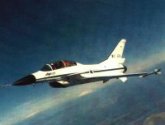
 The Lavi (Young
Lion) was originally developed as a multirole fighter for the
Israeli air force before program cancellation saw the prototypes
used as technology demonstrator airframes. Despite promising
results, the Lavi program was cancelled in 30 August 1987, mainly
due to budget restrictions, US opposition and the availability
of extra, cheaper F-16s.
The main reason for its cancellation, however, was that USA strongly
opposed the whole program; they wanted to sell their fighters
to Israel.
The Lavi (Young
Lion) was originally developed as a multirole fighter for the
Israeli air force before program cancellation saw the prototypes
used as technology demonstrator airframes. Despite promising
results, the Lavi program was cancelled in 30 August 1987, mainly
due to budget restrictions, US opposition and the availability
of extra, cheaper F-16s.
The main reason for its cancellation, however, was that USA strongly
opposed the whole program; they wanted to sell their fighters
to Israel.
The Lavi strongly resembles an F-16A/B
with canard-delta layout; it has an F-16-style
intake, tail, and fuselage. It is powered by a single PW1120
afterburning turbojet, which was derived from the F100. It features
an Elta multimode radar, a HUD, and HOTAS controls.
History
In the early 1980s IAI began developing a multirole fighter to
meet an IDF requirement for around 300 aircraft. The program
go-ahead was given in 1980 and FSD began in October 1982. The
first flight was of B-1, a Lavi TD two-seater (test avionics
filled up the rear seat, however), and occured on 31 December
1986. After the Lavi was canceled, IAI converted the Lavis into
technology demonstrators and testbeds for indigenous avionics
and systems. The third prototype (B-3), a Lavi TD, was completed
as a technology demonstrator, but with pilots in both seats.
It first flew on 25 September 1989.
Chengdu J-10
A Lavi appeard to be housed on a chinese airfield in US satillite
photos. Israel denied lending any Lavis to China, so many people
beliebe the Lavi may form the basis for China's Chengdu J-10
multirole fighter, which is due to enter service early next decade.
The J-10 will serve on China's first carrier, due to be launched
in 2010. The J-10 is believed to be powered by a 122.6kN (27,650
lb) with afterburning Saturn AL-31F turbofan, the same engine
on the Su-27.
More Lavi info...
Nation of Orgin: Israel
Constructor: Israeli Aircraft Industries (IAI)
Type: Multirole attack aircraft
Crew: 1
Length 14.57m (47ft 10in)
Height 4.78m (15ft 8in)
Wingspan 8.78m (28ft 10in)
Wing area 33.1m² (335.8sq ft)
Max T-O Weight 18,370kg (40,500 lb)
Engine: P&W PW1120
Max speed Mach 1.85 (1969km/h; 1063kt)
Combat radius 1110km (600nm).
Minimum Takeoff Run 305m (1000ft).
G Limit +9; TD +7.2
Armament: One internal 30 mm cannon; 7250 kg (16000 lb) on 13
hardpoints, including AAMs, ASMs, rockets and free fall and laserguided
bombs